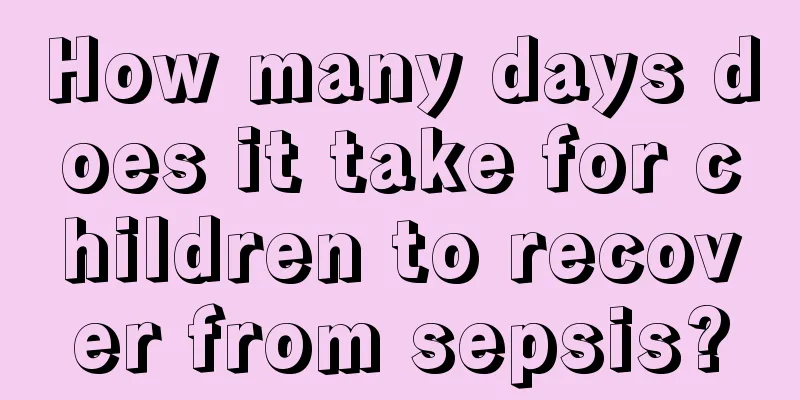How many days does it take for children to recover from sepsis?

|
Children with sepsis need to use some antibiotics during the treatment process. Generally, parents hope that their children can recover as soon as possible, but the recovery time varies due to factors such as the length of illness, the child's physical condition, and the quality of the medication. But generally speaking, the patient's condition will be improved and controlled within three to five days, and he or she can basically recover in about 15 days. Sepsis in children is a bacterial infection, and this infection is a toxic substance that infects the blood. Once such a disease occurs, it must be treated in time, because the disease reproduces quickly and may also harm some reproductive organs. So many of us are confused about the treatment of this disease and don’t know much about it. So what are the symptoms and treatment guidelines of sepsis in children? Symptoms of sepsis in children Sepsis in children is also known as "multiple abscesses". In the past, some people called it "septicemia". Sepsis in children is one of the more serious systemic purulent infections. The pathogenesis of childhood sepsis is that a large number of bacteria gather together to form bacterial emboli. When bacterial emboli intermittently invade the human blood circulation and stay somewhere in the body, causing a series of symptoms, it is called sepsis. The most common pathogens are Staphylococcus aureus and Staphylococcus epidermidis. 1. Systemic manifestations include fever, chills, accelerated heart rate, accelerated breathing, and changes in white blood cell count and classification. 2. Infection increases serum C-reactive protein and procalcitonin. 3. Hemodynamics: cardiac output increases, systemic vascular resistance decreases, and oxygen uptake rate decreases. 4. Metabolic changes: Increased insulin demand and higher blood sugar levels. 5. Changes in tissue perfusion: poor tissue perfusion and decreased urine volume. 6. Organ dysfunction: increased urea nitrogen or creatinine, thrombocytopenia, hyperbilirubinemia, etc. Treatment of sepsis in children What are the treatment guidelines for pediatric sepsis? Come and take a look with the editor of Tiantian Nutrition! 1. Monitoring: Accurately understanding the disease status of sepsis patients is an indispensable part of treating septic shock. Among them, indicators that can reflect the body's hemodynamics and microcirculatory perfusion are particularly important. Therefore, mastering the methods and clinical significance of commonly used monitoring indicators of sepsis is an important skill for doctors. (1) Central venous pressure (CVP) and pulmonary artery occlusion pressure (PAWP). CVP and PAWP reflect the right ventricular end-diastolic pressure and left ventricular end-diastolic pressure, respectively, and are pressure indicators reflecting preload. Central venous catheters should be placed as early as possible in patients with severe sepsis, and pulmonary artery floating catheters should be placed based on their condition. (2) Central venous oxygen saturation (ScvO2) and mixed venous oxygen saturation (SvO2). In the early stages of severe sepsis and septic shock, even if the body's blood pressure, heart rate, urine volume and CVP are within the normal range, systemic tissue perfusion has already occurred insufficiency, and ScvO2 and SvO2 can reflect this tissue perfusion status at an early stage. Studies have shown that in severe sepsis and septic shock, SvO2 (3) Blood lactate. Blood lactate is a sensitive indicator that reflects whether the tissue is in a state of low perfusion and hypoxia. If the lactate level is higher than 4mmol/L, the mortality rate will increase significantly. Dynamic monitoring of blood lactate changes or calculation of lactate clearance is more valuable for assessing disease status. (4) Tissue oxygen metabolism. Gastrointestinal blood hypoperfusion caused by sepsis can lead to ischemia and hypoxia of its mucosal cells, increased H+ release and CO2 accumulation. The gastrointestinal mucosal pH (pHi) is currently an indicator that reflects the oxygenation status of gastrointestinal tissue cells. |
<<: Is breast development painful?
>>: What should I do if my child crosses his eyes?
Recommend
What are some ways for teenagers to lose weight through exercise?
For teenagers, if they are obese while they are g...
Will babies kick their legs when they have flatulence?
Babies are relatively young and their stomachs ar...
Normal vision for a three-year-old child
The vision of a three-year-old baby is close to t...
What are the reasons for children to become fat?
Many babies are actually very fat when they are j...
Boys will grow taller after spermatorrhea
For adolescent boys, nocturnal emission is a very...
What is the reason for a three-year-old child to have eye mucus?
If children have a cold or the weather is dry, th...
What is the best food for a four-month-old baby?
Normally, babies can start eating complementary f...
What are the white spots on the baby's neck?
Babies have weak physical conditions and their im...
The child keeps sniffing his nose
If parents find that their children are always sn...
How many months should babies eat teething biscuits?
As the name suggests, teething biscuits are biscu...
What to do if your one-year-old baby has bloating
For one-year-old babies, the digestive function o...
How long does it take for a newborn to drink water?
Can newborns drink water? The answer is definitel...
What should I do if my baby feels cold after the fever subsides?
What should I do if my baby feels cold after the ...
How to correct crooked feet in newborns
Some newborns have crooked feet after birth. This...
What should I do if my child has a curved spine?
If a child has a curved spine, it is most likely ...









